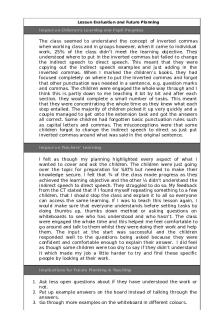Evaluation - spag inverted commas PDF

| Title | Evaluation - spag inverted commas |
|---|---|
| Author | Emmy Sheehan |
| Course | Primary Education |
| Institution | Canterbury Christ Church University |
| Pages | 1 |
| File Size | 41.3 KB |
| File Type | |
| Total Downloads | 81 |
| Total Views | 142 |
Summary
evaluation...
Description
Lesson Evaluation and Future Planning Impact on Children’s Learning and Pupil Progress
The class seemed to understand the concept of inverted commas when working class and in groups however, when it came to individual work, 25% of the class didn’t meet the learning objective. They understood where to put in the inverted commas but failed to change the indirect speech to direct speech. This meant that they were copying out the indirect speech examples and just adding in the inverted commas. When I marked the children’s books, they had focused completely on where to put the inverted commas and forgot that other punctuation was needed in a sentence, e.g. question marks and commas. The children were engaged the whole way through and I think this is partly down to me teaching it bit by bit and after each section, they would complete a small number of tasks. This meant that they were concentrating the whole time as they knew what each step entailed. The majority of children picked it up very quickly and a couple managed to get onto the extension task and got the answers all correct. Some children had forgotten basic punctuation rules such as capital letters and commas. The misconceptions were that some children forgot to change the indirect speech to direct so just put inverted commas around what was said in the original sentence. Impact on Teachers’ Learning
I felt as though my planning highlighted every aspect of what I wanted to cover and ask the children. The children were just going over the topic for preparation for SATS but needed to make their knowledge secure. I felt that ¾ of the class made progress as they achieved the learning objective and the other ¼ didn’t understand the indirect speech to direct speech. They struggled to do so. My feedback from the CT stated that if I found myself repeating something to a few children, that I should stop the class and explain it to all so everyone can access the same learning. If I was to teach this lesson again, I would make sure that everyone understands before setting tasks by doing thumbs up, thumbs down method or asking questions on whiteboards to see who has understood and who hasn’t. The class were engaged the whole time and this helped me feel comfortable to go around and talk to them whilst they were doing their work and help them. The input at the start was successful and the children responded well to the questions being asked because they were confident and comfortable enough to explain their answer. I did feel as though some children were too shy to say if they didn’t understand it which made my job a little harder to try and find these specific people by looking at their work. Implications for Future Planning & Teaching
1. Ask less open questions about if they have understood the work or
not. 2. Put up example answers on the board instead of talking through the
answers. 3. Go through more examples on the whiteboard in different colours....
Similar Free PDFs

20 inverted siphons
- 8 Pages

Commas and gerunds Übung
- 4 Pages

Chapter 9-inverted pyramid
- 6 Pages

Chpt. 9 - Inverted pyramid
- 2 Pages

Positional Inverted Index
- 11 Pages

Evaluation
- 4 Pages

Project Evaluation
- 8 Pages

Final Evaluation
- 17 Pages

Salesforce evaluation
- 15 Pages

CURRICULUM EVALUATION
- 4 Pages

Poster evaluation
- 2 Pages

Policy Evaluation
- 4 Pages
Popular Institutions
- Tinajero National High School - Annex
- Politeknik Caltex Riau
- Yokohama City University
- SGT University
- University of Al-Qadisiyah
- Divine Word College of Vigan
- Techniek College Rotterdam
- Universidade de Santiago
- Universiti Teknologi MARA Cawangan Johor Kampus Pasir Gudang
- Poltekkes Kemenkes Yogyakarta
- Baguio City National High School
- Colegio san marcos
- preparatoria uno
- Centro de Bachillerato Tecnológico Industrial y de Servicios No. 107
- Dalian Maritime University
- Quang Trung Secondary School
- Colegio Tecnológico en Informática
- Corporación Regional de Educación Superior
- Grupo CEDVA
- Dar Al Uloom University
- Centro de Estudios Preuniversitarios de la Universidad Nacional de Ingeniería
- 上智大学
- Aakash International School, Nuna Majara
- San Felipe Neri Catholic School
- Kang Chiao International School - New Taipei City
- Misamis Occidental National High School
- Institución Educativa Escuela Normal Juan Ladrilleros
- Kolehiyo ng Pantukan
- Batanes State College
- Instituto Continental
- Sekolah Menengah Kejuruan Kesehatan Kaltara (Tarakan)
- Colegio de La Inmaculada Concepcion - Cebu



